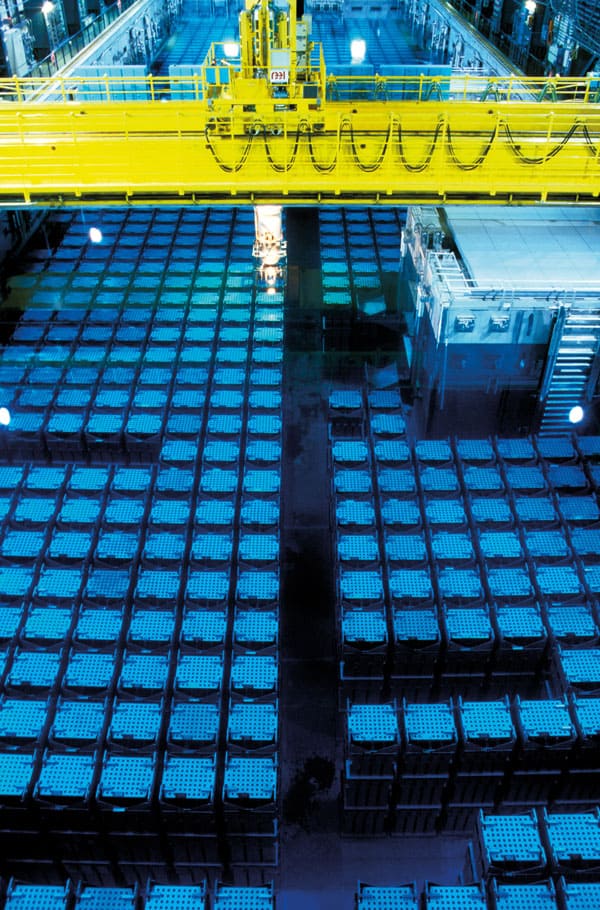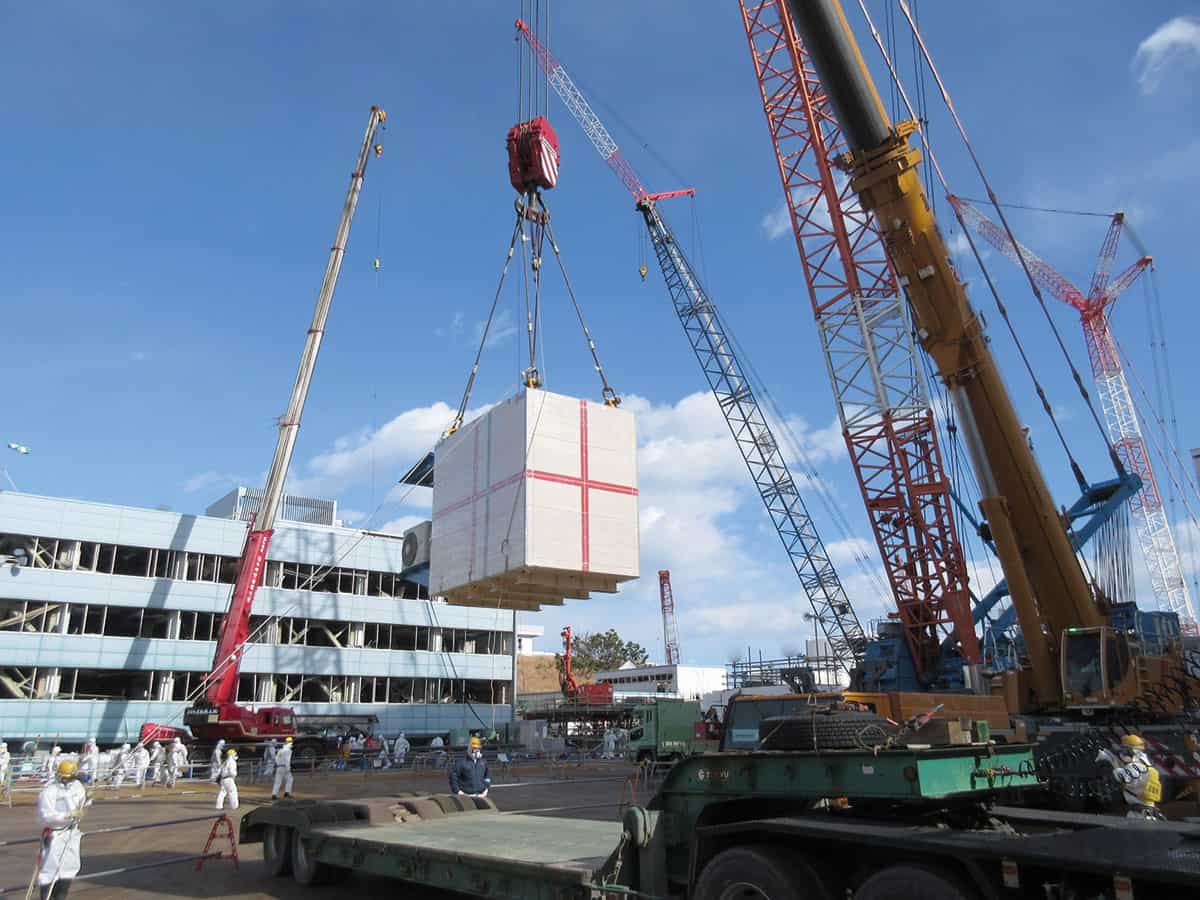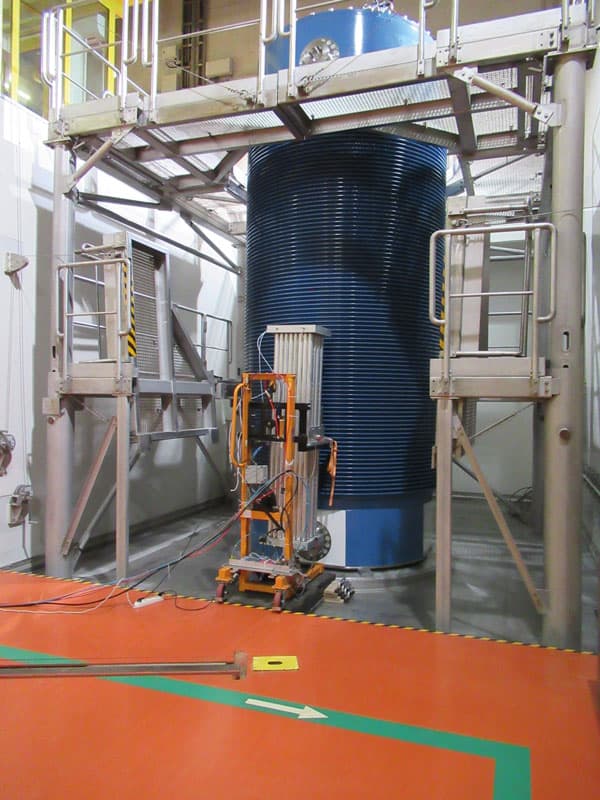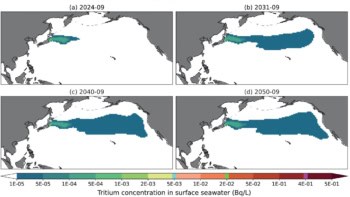Having used them to look through rock, physicists are now exploiting muons to peer inside canisters of radioactive waste. The ability could prove very handy for nuclear inspectors, as Edwin Cartlidge reports

When researchers announced in 2017 that they had discovered a previously unknown void within Egypt’s Great Pyramid, their finding generated much excitement. The 30 m-long cavity, located above the sloping Grand Gallery, prompted new speculation about how the 4500-year-old structure may have been built and whether it might contain hidden burial chambers. But the news also put the spotlight on muons – energetic subatomic particles that can pass through thick layers of dense material and which the scientists in Egypt used to look inside the limestone and granite pyramid.
Muons are generated routinely in particle colliders, where physicists use them to identify other, potentially more exotic, particles within the debris. But they are also produced naturally in the atmosphere, and an ever-growing range of researchers are using these commonly occurring muons as highly penetrating probes. Beyond archaeologists, geologists, for example, are developing muon detectors to establish when magma might be on the rise within a volcano.
There is, however, one application that is particularly well suited to muon radiography – or muography for short – because the material that needs imaging is deliberately made inaccessible to other forms of radiation. That material is nuclear waste – in particular spent fuel, which contains most of the world’s supply of plutonium.
Handling spent fuel is a complex and expensive process designed to keep workers and the public safe while guaranteeing that the fuel can be traced. The International Atomic Energy Agency (IAEA) and other organizations responsible for “safeguarding” the nuclear fuel cycle go to great lengths to ensure that even a tiny fraction of the world’s spent fuel doesn’t fall into the wrong hands and potentially end up in a nuclear weapon or dirty bomb. However, the inability to inspect the fuel directly once it has been stored in casks is a major potential weakness (see box).
Spent fuel: too hot to handle

Nuclear fuel usually comes in the form of uranium pellets encased in metal rods that are bundled together to create fuel assemblies. As the fuel undergoes fission in a reactor, it generates plutonium isotopes and other highly radioactive substances, some of which give off lots of heat. After being removed from the reactor, the fuel is transferred to a large pool of water where it stays for several years to cool down. It is usually then placed into what are known as dry storage casks – concrete or metal canisters several metres high that are lined with a special material to absorb radiation and are stored either close to a reactor or at a special facility.
To keep track of spent fuel, IAEA inspectors can use cameras to watch fuel assemblies being loaded and unloaded from reactors and can monitor the amount of Cerenkov radiation emitted by spent fuel in pools. However, such direct monitoring is not currently possible once the assemblies are placed in casks, since the casks’ thick shielding not only blocks almost all the radiation from inside getting out but also prevents radiation from outside, such as X-rays, getting in.
The inspectors bypass this problem by placing seals on the lids of casks that reveal when they have been tampered with. However, those seals could in principle corrode or become damaged when casks are handled. With accountability of the fuel lost, Matt Durham at Los Alamos says that inspectors would ideally return casks to a cooling pool to open them and re-verify the contents. But doing so would be costly, time consuming and, given the need to transport the waste, potentially dangerous. “This comes down to moving many tonnes of highly radioactive material a long distance, which is non-trivial, to put it mildly,” he says.
Muons offer a way to establish how much waste there is in a container without having to open or move the container in question. That capability would become vital, according to Matt Durham of Los Alamos National Laboratory in the US, should inspectors or the countries involved ever lose confidence in their monitoring. “This issue is only getting worse as more plutonium piles up around the world,” he says.
Muons offer a way to establish how much waste there is in a container without having to open or move the container in question
Making tracks
Muons are fundamental charged particles created when cosmic rays (mainly protons) collide with nuclei in the atmosphere to yield pions that then decay. Having about 200 times the mass of electrons, muons emit little bremsstrahlung radiation and pass quite easily through the atmosphere – some 10,000 of them reaching each square metre of the Earth’s surface every minute. Their high energies allow them to penetrate rock and other dense matter, but they do lose energy as they ionize and excite electrons. Being absorbed after a certain distance – typically several hundred metres in rock – scientists can work out the density of materials they pass through by measuring variations in their flux.
Atmospheric muons were first used in this way back in the mid-1950s by British physicist Eric George, who measured the thickness of ice above a mining tunnel in Australia. But it was not until 2003 that Durham’s Los Alamos colleague Christopher Morris and several co-workers proposed using the scattering of muons, instead of their absorption, to image concealed dense objects, particularly nuclear material (Nature 422 277).
The idea is that muons are deflected by the dense concentrations of charge inside atomic nuclei, and the greater a material’s atomic number (Z), the bigger that deflection will be. This means that uranium, for example, will scatter incoming muons much more than lower-Z materials such as concrete and steel. Therefore, an object’s composition can be worked out by plotting the trajectories of muons before they enter the object and after they leave it. Given a long enough exposure time, the researchers reasoned, muons can be recorded over a wide range of incident angles and positions, thereby providing an accurate image of the object’s contents.
Morris and colleagues used detectors known as drift tubes, each of which contains gas and a positively charged wire that runs along its length. Any passing muon ionizes the gas where it crosses a tube, liberating electrons that register a signal at that point along the wire. By arranging adjacent layers of tubes at right angles to one another, it is possible to map a series of points along each muon’s trajectory. At least two sets of perpendicular layers on either side of an object are therefore needed to plot a muon’s incoming and outgoing vectors.
The Los Alamos researchers first demonstrated the technique by imaging a simple tungsten cylinder. They then went on to develop detectors designed to reveal nuclear materials hidden among cargo in trucks and shipping containers. Having received funding for this following the terrorist attacks in New York in 2001, they made a prototype device for a California-based company called Decision Sciences Corporation. Morris says that the firm has since begun to sell detectors within the US and overseas.
Turning their attention to spent fuel, Morris, Durham and colleagues developed two muon trackers, each consisting of 24 layers with 24 1.2 m-long drift tubes in each. To put these devices to the test, they moved them north to the Idaho National Laboratory and placed them either side of a dry storage cask taken out of a Westinghouse reactor in the 1980s. Recording nearly half a million muon tracks over the course of three months in 2016, they set out to determine which of the cask’s 24 fuel-assembly slots were full and which were empty. Doing so, they correctly identified whether or not slots were empty in four out of six slot groupings (Phys. Rev. Applied 9 044013).
Testing times
The Los Alamos group ultimately aims to show that muons can be used to identify not only whether fuel assemblies are missing but also if they have been replaced by dummy objects – made from lead, for example. This would involve combining both scattering and absorption measurements, given that muons’ deflection depends on a material’s atomic number and density whereas their absorption depends only on its density. Combining the two techniques means being able to subtract the density information from the scattering measurements, so establishing the atomic number and therefore identify the material.
The researchers have used computer simulations to show that such discrimination should be possible but must wait before they can prove this experimentally. Having been unable to identify all the missing fuel-assembly slots in their Idaho test because strong winds blew the detectors out of alignment, they had hoped to carry out new tests with the detectors fastened in place. But Morris says that the Department of Energy’s National Nuclear Security Administration hasn’t given them the necessary funds.

The group had also hoped to apply its technology to imaging damaged reactor cores, specifically those at the Fukushima nuclear power plant in Japan. Following the disaster in 2011, Fukushima’s operator, the Tokyo Electric Power Company (TEPCO), wanted to use muons to help locate melted fuel within the plant’s reactors in order to remove that fuel later on. And indeed between 2015 and 2017 the company used measurements of muon absorption to show that much of the fuel in reactor units 1 to 3 had fallen out the respective reactor cores.
According to Morris, absorption radiography is not ideally suited to the task, given the similar densities of nuclear fuel and water. He and his colleagues at Los Alamos therefore worked with physicists at Toshiba to develop scattering detectors, which they tested successfully at a small Toshiba reactor in Yokohama. However, this technology was considered too expensive and disruptive to be used at Fukushima. “We were very disappointed not to make measurements,” says Morris.
In Europe, however, interest appears to be growing. That is particularly true in Germany, which is due to close all of its remaining nuclear power plants by 2022 and as such will need to remove and store large amounts of spent fuel. Durham points out that once all the plants in the country have been closed there will be no cooling pools available to look inside casks, and he doubts that France or any other nuclear-powered neighbour would agree to inspect the waste. “Everybody has enough problems dealing with their own,” he says.
As such, German scientists are investigating ways of looking inside dry storage casks – in particular muography. Katharina Aymanns of the Jülich Research Centre near Cologne, who is co-ordinating the initiative, says this is particularly important given that Germany is unlikely to have a permanent repository until at least 2050. The idea, she says, is “to make sure that all the fuel assemblies that you think are in a cask are actually in a cask”.
To this end, Aymanns contacted Paolo Checchia at the Legnaro National Laboratory in Padua, Italy. Checchia and colleagues are also working on muography detectors made from drift tubes – in this case based on technology developed for the CMS detector at the CERN laboratory in Geneva. They have done simulations showing that such technology should make it possible to spot when a fuel assembly has gone missing from a storage cask, and have built a small (2 m × 0.5 m) prototype detector consisting of 64 drift tubes in eight layers.

Last year, Checchia and co-workers carried out tests partly funded by Euratom, the body responsible for spent-fuel inspections within Europe. Those tests involved placing the prototype device next to a “Castor” cask at the Neckarwestheim nuclear power plant near Stuttgart. Although not able to study the contents of the cask in any detail, the researchers showed that they could detect muon tracks above the small amount of radiation emitted by the cask itself, and also demonstrated that the cask blocked some of the incoming muons. To identify missing fuel assemblies they next hope to perform tests using a pair of larger trackers.
Other countries that might benefit from muography include Finland and Sweden, which are both developing geological waste repositories. Morris and colleagues carried out simulations showing that 24 hours of muon scattering measurements would be enough to identify any missing or replaced fuel assemblies within the copper and iron casks that will be used in Scandinavia. The researchers write that such measurements, carried out immediately before burial, would represent “the last chance for inspectors to evaluate state declarations of spent fuel disposal”.
Drums of waste
In addition to monitoring spent fuel itself, however, muon technology can also be used to image other types of nuclear waste, including the metal cladding that is stripped from fuel rods before spent fuel is reprocessed. The UK alone is home to many tens of thousands of 500 litre stainless-steel drums containing this cladding material immersed in concrete.
In addition to monitoring spent fuel, muon technology can also be used to image other types of nuclear waste
Ralf Kaiser of the University of Glasgow says that some of the drums have been found to bulge, which means that they might contain fragments of spent fuel – given that uranium increases in volume when it oxidizes. But since the drums are not easy to get at, he explains, it is not known how many might be affected. He says that because the drums could potentially crack open, identifying such fragments early on could prevent harmful and expensive radiation leaks.
To inspect such drums, Kaiser and colleagues at Glasgow have developed muon detectors consisting of thousands of plastic scintillating fibres (Philosoph. Trans. Roy. Soc. A 377 20180048). Working with scientists from the National Nuclear Laboratory at the Sellafield reprocessing plant, the Glasgow group developed a small prototype and then a full-scale system large enough to house one 500 litre drum. Carrying out a series of laboratory tests from 2015 onwards, the researchers showed they could image a range of objects inside a concrete drum, including a 3 cm-long cylinder of uranium.
After seven years of research, the Glasgow group was assigned intellectual property rights for the work and in 2016 set up a company called Lynkeos Technology. The firm has since embarked on its first commercial contract: to image vitrified waste generated using a new technique known as GeoMelt. Having shown in the lab that passing muons reveal how uniformly the waste melts and whether it contains any metallic items, the group has been using the detector on-site at Sellafield since October 2018 to image waste containing radioactive material, including uranium. It is now preparing to image larger (3 m3) waste boxes.

Seeing past the ordinary
Inspection of waste other than spent fuel – be that fuel cladding or contaminated spanners, for example – is also the aim of researchers at the universities of Bristol and Sheffield in the UK, and Warsaw Technical University in Poland. This collaboration is currently commissioning a 5 m-high detector based on resistive plate chambers, which pick up ionizations in gas using metallic strips placed outside glass plates. As to where the device could be tested, group leader Jaap Velthuis of the University of Bristol says that several utilities in Europe are interested but none has committed so far. “It’s not easy to get on sites with nuclear waste and ask them to get their drums out,” he points out.
Indeed, given the sensitivity that surrounds the subject of nuclear waste, developing any new technology that could help deal with it is not an easy process. That is particularly true when it comes to spent fuel, and it remains to be seen just how willing safeguard agencies will be to adopt muon detection. The IAEA say that it does not currently use the technology for nuclear verification, “as there are still limitations on its use for this purpose”. However, it adds that it is “following research activities in this area”.
Aymanns underlines that it is for the IAEA and other safeguard organizations to decide whether and when they field a particular technology. In the meantime, she says, scientists “can help just by doing field tests”. But she has little doubt that new technology is needed. “Even if you have surveillance you have to be prepared for it to fail,” she says. “Maybe it will never happen but if it ever does you have to be ready.”



